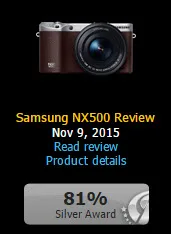
This week, we report on the withdrawal from the UK digital camera market by Samsung, which follows on from a story we spotted recently that the firm had dropped out of selling cameras in Germany as well. The position on the rest of Europe remains unclear, but the withdrawal rumours started some weeks ago when the NX1 mirrorless camera was withdrawn across the whole region.
Now, companies, especially those with such a huge range as Samsung, often find that in some segment, they don’t have the right technology, miss important technology waves or can’t get enough volume to achieve a profit in a particular market segment. In the case of Samsung’s digital cameras, the first two situations certainly don’t apply. Our favourite camera review site, dpreview.com, recently gave its “Silver Award” to the Samsung NX500 and the NX1 was described as having “class-leading image and video quality”. The NX500 is compared favourably to the best cameras in its segment*.
Some years ago, I wrote about an experience I had at a Photokina show in Germany. Samsung was relatively new to the “serious” photography market, and had a large booth next to Canon. The Canon booth was heaving with people trying out cameras and lenses, while the Samsung booth was almost empty. To me, it highlighted the importance of branding and that brands do not exist independently of the markets they serve. Samsung had a massive brand at the time, but not the brand that it needed in photography.
Canon, Nikon and, more recently, Sony (since its acquisition of the Konica Minolta business) have been the biggest brands in the mainstream professional digital camera market. (I found estimates in preparing this article that put the shares at 39%, 34% and 13% respectively). This position means that even serious amateurs and aspiring professionals want to own this high end kit.
Samsung didn’t build this aspirational high end and I suspect that this was a problem for the company in getting the recognition that it deserved for the quality of the products that it produced. Panasonic may struggle in the longer term for the same reason, although it too, produces excellent enthusiast products.
The reality is also, of course, that there used to be a pyramid of cameras from the low end to the very exotic. The low end market has been more or less destroyed by the arrival of the smartphone (the DSC market is said to have dropped from a peak in 2010 at 120 million to just over 40 million in 2014 – Source:CIPA). For a number of years, my favourite question to ask when talking about branding and positioning was “What is the biggest camera company?”. Typically the answer would be “Canon” or “Nikon”, but the answer, in volume terms, was Nokia, which went from not selling cameras at all to being the highest volume camera maker in just a couple of years. Of course, on this basis, Samsung remains the largest camera vendor on a volume basis because of its smartphone sales.
The reality is that the middle market is going to be very difficult for those that cannot build huge volume from the low end, but also struggle to get a premium as they are not in the aspirational professional market. Historic medium format company, Mamiya, which was fits this description, was sold this week and others such as Pentax and Minolta have been sold in recent years.
So, it looks as though Samsung has realised that with its dominance of the volume end of the camera market and the huge investment that would be needed to attack the professional market, it makes more sense to simply withdraw. It will, of course, compete in the sensor semiconductor market in competition with market leader, Sony.
Bob
*While researching this article, I found some interesting rumours that Samsung is planning to sell its mirrorless camera technology to Nikon which may use Samsung’s sensors, which DPReview rates very highly. Samsung denied the rumours yesterday but has said it will make an announcement about its imaging business at CES next month.

